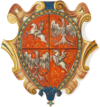Abdank coat of arms
| Abdank | |
|---|---|
 | |
| Battle cry | Abdaniec, Abdank, Awdaniec, Habdank, Hebdank |
| Alternative name(s) | Abdaniec, Abdanek, Abdank, Avdank, Awdancz, Awdaniec, Białkotka, Biłkotka, Czelejów, Habdaniec, Habdank, Haudaniec, Hawdaniec, Hebdank, Łąkotka, Łękawa, Łękawica, Skuba, Szczedrzyk |
| Earliest mention | 1212 (seal) |
| Families | 688 names |
| Cities | Obertyn, Rożniatów |
Abdank is a Polish coat of arms. It was used by several szlachta families in the times of the Kingdom of Poland and the Polish–Lithuanian Commonwealth.[2][3]
Blazoning
[edit]Gules łękawica[4] argent, crest: łąkawica as in arms.
History
[edit]According to Kasper Niesiecki, the beginning of this shield dates from the time of Krakus, a mythological Polish monarch who founded and gave his name to the city of Kraków.[5] On Wawel Mount, where Kraków's castle stood, from the Wisła (Vistula) river side, a man-eating dragon showed up. One day a man called Skuba, a young shoemaker, took the skin of a flayed sheep, put tar and sulphur and fire-brand into it and threw it into the dragon's lair. The dragon, not recognizing the deception, assumed it was a sacrifice from the people of Kraków and ate the fake sheep. The fire in his belly ignited it and as a result the dragon became very thirsty. He drank and drank the water from the Wisła river until he finally exploded and died. For his heroic deed Krakus granted Skuba the letter "W" to his shield, standing either for wąż (snake) or for Wawel. This letter can be seen on the Abdank coat of arms.
The Awdaniec Clan (such as it may be) has been called variously: "Awdaniec," "Abdaniec," "Abdanka," "Awdanc," "Awdanczyc," "Habdaniec," "Habdank," "Habdaniec," "Hebdank," "Lakotka," "Lekawa," "Lekawica," "Lekotka," "Bialkotka," "Szczedrzyk," "Skuba," and probably other things similar and dissimilar. Known recorded war cries are: "Abdaniec!," "Abdank!,""Awdaniec!," "Habdank!," and "Hebdank!."[6]
Abdank in literature
[edit]In Henryk Sienkiewicz's "With Fire and Sword" the Cossack leader Bohdan Khmelnytsky, wishing to hide his true identity, falsely introduces himself to the main protagonist Skrzetuski as "Zenobi Abdank, Abdank Coat of Arms, Abdank with a cross, a nobleman of Kiev county".

Notable bearers
[edit]Notable bearers of this Coat of Arms include:
- Józef Ankwicz, Deputy to the Great Sejm
- Andrzej Alojzy Ankwicz, Roman Catholic archbishop of Prague
- Skarbmir count palatine of Poland
- Bernard Zdzisław Skarbek, Count, Colonel 3rd Carpathian Rifle Division (Poland); World War II battles: Battle of Monte Cassino, Battle of Ancona, Battle of Bologna
- Martynas Goštautas
- Jonas Goštautas
- Albrecht Goštautas
- Stanislovas Goštautas
- Marian Toczyński
- Jerzy Jazłowiecki
- Bohdan Khmelnytsky, leader of the Khmelnytsky Uprising
- Jan Konarski, Bishop of Kraków
- Alfred Korzybski, linguist
- Jan Kozietulski, commander of the Polish cavalry charge at the Battle of Somosierra
- Ignacy Skarbek-Kruszewski, Polish and Belgian general
- Boguslaw Kruszewski, sailor
- Mikołaj Kruszewski
- Miroslawa Kruszewska, writer, poet
- Konrad Johann Kruszewski, artist, graphic designer
- Mieszko Boguslaw Kruszewski, translator, writer
- Tomasz Włodzimierz Kruszewski, veteran
- Kazimierz Rudzki
- Wilfrid Voynich (born Michał Habdank-Wojnicz)
- Ivan Vyhovsky, Ataman of the Ukrainian Cossacks
- Christine Granville (born Krystyna Skarbek)
- Michał Haraburda
See also
[edit]Related coat of arms
[edit]Notes
[edit]- ^ Chorowiec, Oleg. Herbarz Szlachty Wołyńskiej, Vol. V, Radom 2016
- ^ Paprocki, Bartosz. Herby Rycerstwa Polskiego, 1584, p. 216-229
- ^ Niesiecki, Kasper. Herbarz Polski, 1839
- ^ Łękawica is a typical Polish charges, similar to letter W. Alternative description two chevrons couped, reversed and conjoined.
- ^ Niesiecki, Kasper. Herbarz Polski, 1839, Tom II, p. 1
- ^ "Wappengemeinschaft Abdank - Ahnenforschung.Net Forum".
Bibliography
[edit]- Bartosz Paprocki: Herby rycerstwa polskiego na pięcioro ksiąg rozdzielone, Kraków, 1584.
- Tadeusz Gajl: Herbarz polski od średniowiecza do XX wieku : ponad 4500 herbów szlacheckich 37 tysięcy nazwisk 55 tysięcy rodów. L&L, 2007. ISBN 978-83-60597-10-1.

